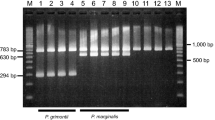Abstract
A simple and rapid assay for the detection of Bacillus weihenstephanensis isolates and other psychrotolerant strains in the Bacillus cereus group was developed. It is based on the presence of a nucleotide substitution at position 795 on the housekeeping pycA gene in all B. weihenstephanensis strains. This mutation creates a PstI recognition site. It is absent in mesophilic strains in the B. cereus group. The pycA gene is amplified by PCR and the amplicons submitted to PstI digestions. In mesophilic strains, a single band of 1,718 bp in length is visualised on an agarose gel. In B. weihenstephanensis strains and in all other psychrotolerant strains from the B. cereus group, the amplicons are cleaved and two bands of 1,175 and 543 bp, respectively, are visualised. This method could be used for the screening of B. cereus collections and for the identification of psychrotolerant and mesophilic isolates from different environments.


Similar content being viewed by others
References
Bartoszewicz M, Bideshi DK, Kraszewska A, Modzelewska E, Swiecicka I (2009) Natural isolates of Bacillus thuringiensis display genetic and psychrotrophic properties characteristic of Bacillus weihenstephanensis. J Appl Microbiol 106:1967–1975
Dufrenne J, Bijwaard M, te Giffel M, Beumer R, Notermans S (1995) Characteristics of some psychrotrophic Bacillus cereus isolates. Int J Food Microbiol 27:175–183
Gounot AM (1991) Bacterial life at low temperature: physiological aspects and biotechnological implications. J Appl Bacteriol 71:386–397
Guinebretière MH, Auger S, Galleron N, Contzen M, De Sarrau B, De Buyser ML, Lamberet G, Fagerlund A, Granum PE, Lereclus D, De Vos P, Nguyen-The C, Sorokin A (2013) Bacillus cytotoxicus sp. nov. is a new thermotolerant species of the Bacillus cereus Group occasionally associated with food poisoning. Int J Syst Evol Microbiol 63:31–40
Larsen HD, Jørgensen K (1997) The occurrence of Bacillus cereus in Danish pasteurized milk. Int J Food Microbiol 34:179–186
Lechner S, Mayr R, Francis KP, Prüß BM, Kaplan T, Wießner-Gunkel E, Stewart GSAB, Scherer S (1998) Bacillus weihenstephanensis sp. nov. is a new psychrotolerant species of the Bacillus cereus group. Int J Syst Bacteriol 48:1373–1382
Logan NA, De Vos P (2009) Genus I. Bacillus Cohn 1872, 174AL. In: De Vos P, Guarrity GM, Jones D, Krieg NR, Ludwig W, Rainey FA, Schleifer K-H, Whitman WB (eds) Bergey’s manual of systematic bacteriology, 2nd edn. Springer, New York, pp 21–128
Meer RR, Baker J, Bodyfelt FW, Griffiths MW (1991) Psychrotrophic Bacillus spp. in fluid milk products: a review. J Food Protection 54:969–979
Páčová Z, Švec P, Stenfors LP, Vyletělová M, Sedláček I (2003) Isolation of the psychrotolerant species Bacillus weihenstephanensis from raw cow’s milk. Czech J Anim Sci 48:93–96
Paniker G, Aislabie J, Saul D, Bej AK (2002) Cold tolerance of Pseudomonas sp. 30–3 from oil-contaminated soil, Antarctica. Polar Biol 25:5–11
Paniker G, Aislabie J, Bej AK (2006) Analysis of aggregative behavior of Pseudomonas sp. 30–3 isolated from Antarctic soil. Soil Biol Biochem 38:3152–3157
Sanger F, Nicklen S, Coulson AR (1977) DNA sequencing with chain-terminating inhibitors. Proc Natl Acad Sci USA 74:5463–5467
Schär J, Regina Stol R, Schauer K, Loeffler DIM, Eylert E, Joseph B, Eisenreich W, Fuchs TM, Goebel W (2010) Pyruvate carboxylase plays a crucial role in carbon metabolism of extra- and intracellularly replicating Listeria monocytogenes. J Bacteriol 192:1774–1784
Soufiane B, Côté J-C (2009) Discrimination among Bacillus thuringiensis H serotypes, serovars and strains based on 16S rRNA, gyrB and aroE gene sequence analyses. Antonie Van Leeuwenhoek 95:33–45
Soufiane B, Côté J-C (2010) Bacillus thuringiensis serovars bolivia, vazensis and navarrensis meet the description of Bacillus weihenstephanensis. Curr Microbiol 60:343–349
Soufiane B, Baizet M, Côté J-C (2013) Multilocus sequence analysis of Bacillus thuringiensis serovars navarrensis, bolivia and vazensis and Bacillus weihenstephanensis reveals a common phylogeny. Antonie Van Leeuwenhoek 103:195–205
Stenfors LP, Granum PE (2001) Psychrotolerant species from the Bacillus cereus group are not necessarily Bacillus weihenstephanensis. FEMS Microbiol Lett 197:223–228
Tang KH, Tang YJ, Blankenship RE (2011) Carbon metabolic pathways in phototrophic bacteria and their broader evolutionary implications. Front Microbio 2:165. doi:10.3389/fmicb.2011.00165
Svensson B, Eneroth A, Brendehaug J, Molin G, Christiansson A (2000) Involvement of a pasteurizer in the contamination of milk by Bacillus cereus in a commercial dairy plant. J Dairy Res 67:455–460
Van Netten P, Van De Moosdijk A, Van Hoensel P, Mossel DAA, Perales I (1990) Psychrotrophic strains of Bacillus cereus producing enterotoxin. J Appl Microbiol 69:73–79
Vilas-Bôas GT, Peruca AP, Arantes OM (2007) Biology and taxonomy of Bacillus cereus, Bacillus anthracis, and Bacillus thuringiensis. Can J Microbiol 53:673–687
Author information
Authors and Affiliations
Corresponding author
Rights and permissions
About this article
Cite this article
Soufiane, B., Côté, JC. Discrimination Between Mesophilic and Psychrotolerant Strains in the Bacillus cereus Group Based on the PstI Digestion of the pycA Gene. Curr Microbiol 67, 148–155 (2013). https://doi.org/10.1007/s00284-013-0339-0
Received:
Accepted:
Published:
Issue Date:
DOI: https://doi.org/10.1007/s00284-013-0339-0




